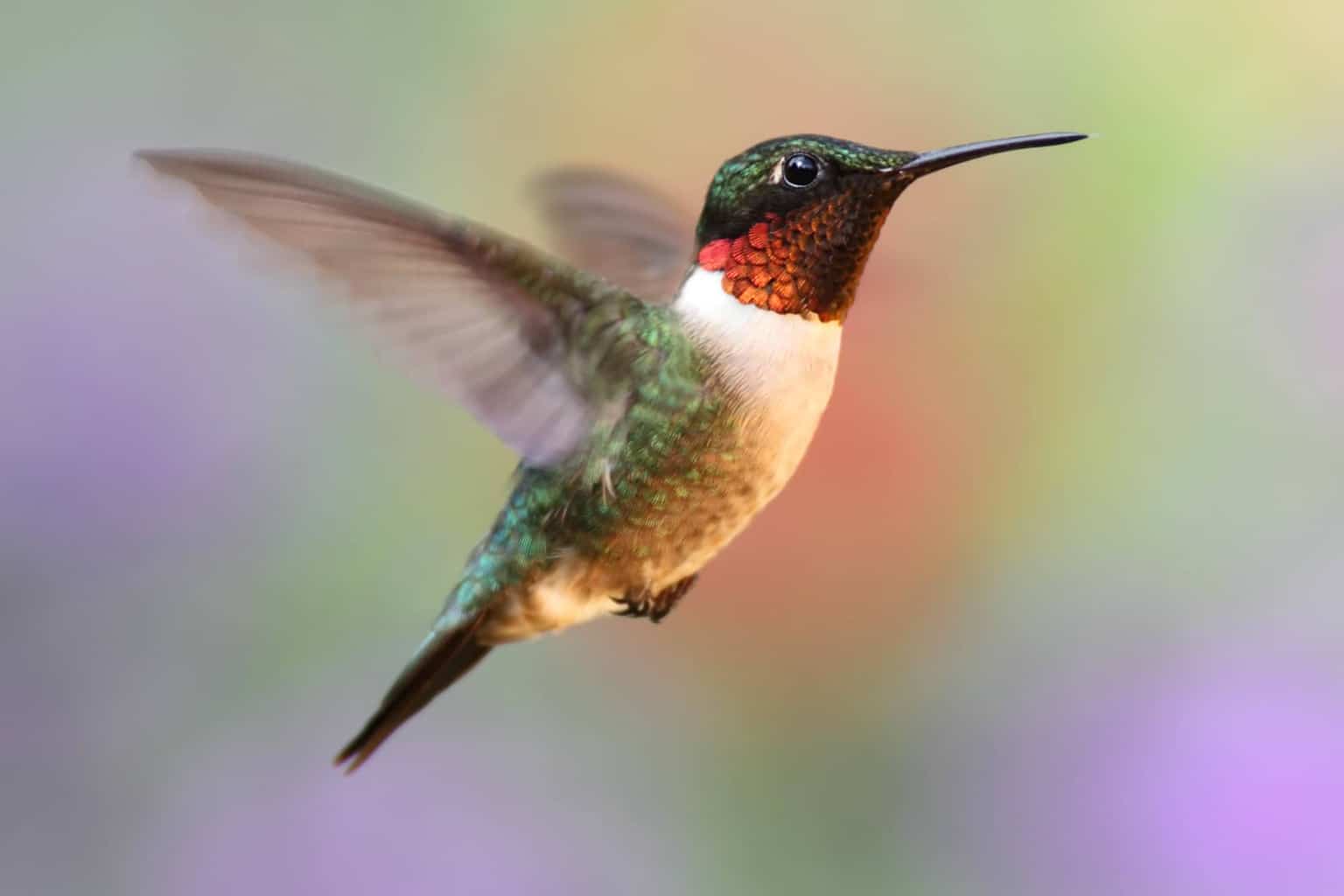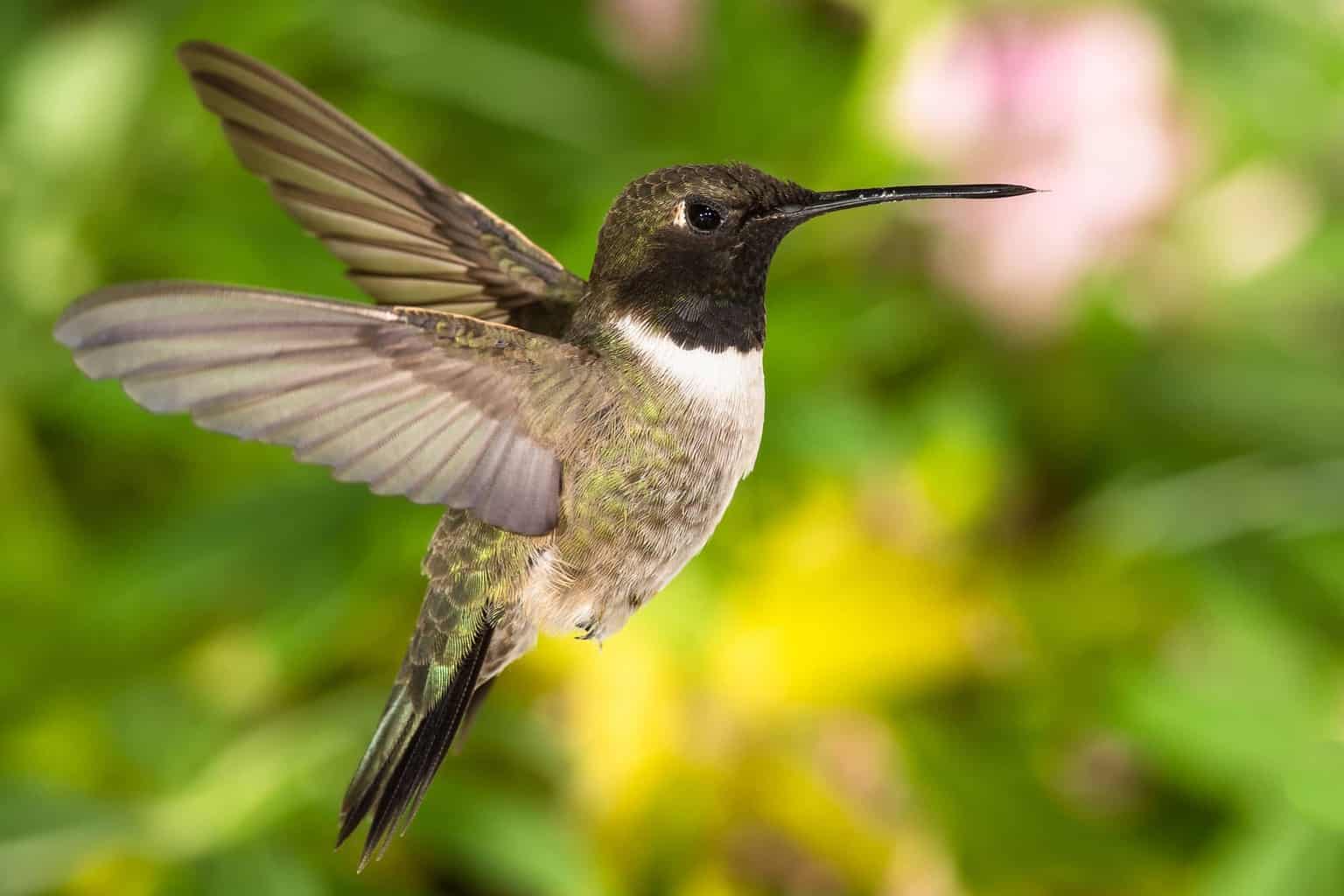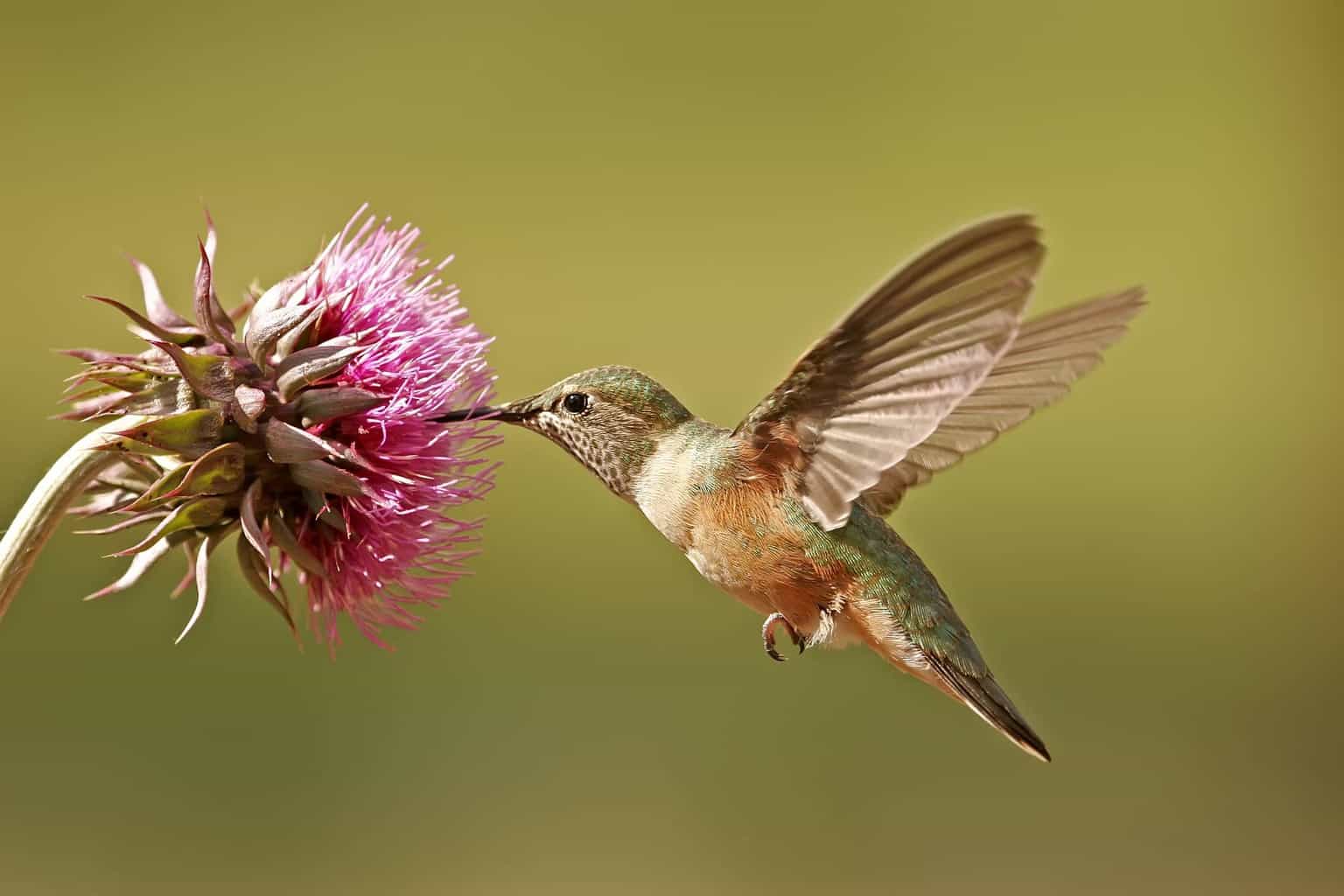Oklahoma is a transition zone between western semi-arid, northern humid continental, and eastern and southeastern humid subtropical climates.
It experiences more severe weather than virtually anywhere else on earth, receiving an average of 39 inches of rain and 6 inches of snow a year.
The central parts of the state are low-lying, while the western panhandle is part of the Rocky Mountains and parts of the east are in the Ozark and Ouachita Mountains.
Oklahoma has various plant and animal species, including 480 bird species.
Three species are commonly found, of which two nest in the state, namely the ruby-throated and the black-chinned hummingbirds. The rufous hummingbird migrates through the state.
There are, however, several occasional vagrants.
Identifying Hummingbirds In Oklahoma
Ornithologists classify hummingbirds into the family Trochilidae, which is exclusive to the Americas.
These tiny birds can not only hover with their wings beating at a speed that makes a humming noise —they can also stop instantly and can fly backward, the only birds with this ability.
They use these flying abilities to drink nectar from flowers, adding to their diet arthropods that they catch on the wing (hawking), take from leaves or flowers, or even pull from spiderwebs.
They can burn both glucose and fructose. In fact, hummingbirds are the only vertebrates that can burn fructose.
We can classify the hummingbirds found in Oklahoma as Frequently Found, Seasonal Migrants, and Accidental Vagrants.
Hummingbirds Frequently Found in Oklahoma
Only two species of hummingbird are frequently found in Oklahoma.
Ruby-throated Hummingbirds (Archilochus colubris)

- Length: 2.8 – 3.5 inches
- Weight: 0.1 – 0.2 ounces
- Wingspan: 3.1 – 4.3 inches
Description:
A medium-sized hummingbird, Ruby-throated hummingbirds have emerald green backs, wings, heads, and a pale gray underbelly. Their tails are forked.
Ruby-throated female hummingbirds and immature birds of the species have a white, speckled throat; mature males have ruby-red throat feathers that give this bird its name.
Additional Information:
These hummingbirds occur across most of the eastern United States in the summer months, their breeding season. They are the most common hummingbirds in the eastern three-fourths of Oklahoma.
They inhabit the margins of deciduous forest, stream banks, meadows, old fields, orchards, and gardens.
They feed on nectar from red and orange tubular flowers such as flame azalea, native honeysuckles, and red morning glory. They supplement this with small insects.
They arrive between April 10th and 20th at their summer breeding grounds and depart for their wintering grounds in Central America by the end of October.
Male ruby-throated hummingbirds exhibit territorial behavior, defending nectar sources and hummingbird feeders against other hummingbirds.
Black-chinned Hummingbirds (Archilochus alexandri)

- Length: 3.5 inches
- Weight: 0.1 – 0.2 ounces
- Wingspan: 4.3 inches
Description:
Black-chinned hummingbirds have green backs, heads, and wings. Female and immature birds have a pale grayish to white underbelly. The throat is sometimes lightly speckled.
Male black-chinned hummingbirds have a green belly and a gray chest. Their throats are black, hence the species name, with a strip of iridescent purple at the lower edge.
Additional Information:
Black-chinned hummingbirds live around streamsides, agave-cactus desert, juniper-live oak woodland, parks, and gardens.
They feed on nectar and insects.
In the summer, black-chinned hummingbirds are found from British Columbia to California and Texas in the south.
Western Oklahoma is part of their range, and they are the most common hummingbirds around Lawton and Altus. They are now common as far east as Chickasha.
Seasonal Migrant Hummingbirds Of Oklahoma
One hummingbird species is a seasonal migrant to Oklahoma, namely the rufous hummingbird.
Rufous Hummingbirds (Selasphorus rufus)

- Length: 2.8 – 3.5 inches
- Weight: 0.07 – 0.18 ounces
- Wingspan: 4.0 – 4.5 inches
Description:
Female and immature rufous hummingbirds have greenish backs, heads, and wings, with rusty flanks and rusty patches on their green tails. Their chests are white.
Male rufous hummingbirds have vivid coppery backs and bellies, an iridescent rusty-orange throat, green shoulders, and a white chest. The tail comes to a point when folded.
Additional Information:
Rufous hummingbirds feed along forest edges, streamsides, and mountain meadows.
They breed in forest edges, clearings, and brushy second growth in the west and northwest of North America.
They leave the western states in July and August, migrating through the Rocky Mountains to take advantage of wildflowers and winter in southern California, Arizona, and Mexico.
Their diets consist chiefly of nectar from tubular flowers, insects, and tiny spiders. They drink sap from holes made by sapsuckers (a genus of woodpeckers).
Rufous hummingbirds are exceptionally aggressive hummingbirds, defending nectar sources against intruders, even larger hummingbirds, and rodents.
Accidental Vagrant Hummingbirds in Oklahoma
The following hummingbird species typically reside in other regions of the United States, but occasional sightings happen in Oklahoma.
You may see immature birds or ones in subdued plumage, making it difficult for you to identify them. People sometimes mistake hawk moths for hummingbirds.
Anna’s Hummingbirds (Calypte anna)

- Length: 3.9 – 4.3 inches
- Weight: 0.1 – 0.2 ounces
- Wingspan: 4.7 inches
Description:
Female and immature Anna’s hummingbirds have metallic green upper parts, grayish undersides, and some reddish-pink throat feathers.
Male Anna’s hummingbirds are overall metallic green, the green being darker on their backs. Their throats and crowns are rose-pink.
Additional Information:
Anna’s hummingbirds are found along the Pacific coastline, from southern Alaska to northern Mexico. They are one of only three species to permanently resident in the US or Canada.
Anna’s hummingbirds are the only hummingbirds to winter in northern climates, migrating from higher altitudes in the summer to lower altitudes in the winter.
They utilize various habitats in their range, including streamsides, coastal scrub, open woodlands, gardens, and parks.
Their diet consists of nectar and insects.
Anna’s hummingbirds are more vocal than other species, with their males exhibiting a buzzing hummingbird song. The males also make fancy dive displays at other birds and even people.
Mexican Violetear Hummingbirds (Colibri thalassinus)

- Length: 3.8 – 4.7 inches
- Weight: 0.17 – 0.20 ounces
- Wingspan: 4.7 inches
Description:
These medium-sized hummingbirds have mostly green backs and bellies, although females and immature birds have more subdued plumage. Their tails are squared off.
Males show a glittering green throat and chest, with an iridescent violet ear-patch. Their rumps are bronze; their tails are metallic bluish-green with a black band above the bottom.
Additional Information:
Mexican violetear hummingbirds utilize forest clearings and forest edges in humid areas.
They occur primarily in Mexico and Central America.
There have been sightings across the USA, mainly in the western states and as far north as Canada.
They feed on nectar and insects.
Ornithologists previously considered this species and the lesser violetear part of the same species (conspecific) under the name green violetear.
Allen’s Hummingbirds (Selasphorus sasin)

- Length: 3.0 – 3.5 inches
- Weight: 0.10 – 0.15 ounces
- Wingspan: 4.3 inches
Description:
Female and immature Allen’s hummingbirds are light copper, with green backs. The green back is the critical feature that distinguishes this species from the rufous hummingbird.
Males have copper-colored tails and bellies, green backs, and metallic reddish-orange throats.
Additional Information:
Allen’s hummingbirds inhabit coastal forests, open oak woodland, scrub, gardens, and parks.
This species nests in coastal California and winters in Mexico. With climate change, more remain in California all year round or migrate east for the winter.
Allen’s hummingbirds feed on nectar and insects.
Broad-tailed Hummingbirds (Selasphorus platycercus)

- Length: 3.1 – 3.5 inches
- Weight: 0.1 – 0.2 ounces
- Wingspan: 5.25 inches
Description:
Broad-tailed hummingbirds have green backs, heads, tails, and a white chest.
Females and immature birds have throats and cheeks spotted with green. Males have magenta throats.
Additional information:
Broad-tailed hummingbirds breed in pine-oak woodlands and juniper scrub, at high elevations up to 10,500 feet above sea level, in early April to mid-June.
Because overnight temperatures in their breeding locations often drop below freezing, they enter a state of torpor, lowering their body temperature and their heart rate.
Broad-tailed hummingbirds occur from western Canada to southern Mexico. They are only found in the United States from late May to early August, mainly in the western states.
Their diet consists of nectar and insects.
Calliope Hummingbirds (Stellula calliope, formerly Archilochus calliope)

- Length: 2.8 – 3.9 inches
- Weight: 0.07 – 0.11 ounces
- Wingspan: 4.1 – 4.3 inches
Description:
Calliope hummingbirds are tiny hummingbirds with a hunchback posture. Females and immatures have green backs and a peach-colored wash across their underbellies.
Male Calliope hummingbirds have green backs, greenish-gray chests, and characteristic, distinct rays of magenta feathers on their throats.
Additional information:
Calliope hummingbirds live in forest clearings, canyons, and streamsides, breeding from 4,000 feet above sea level to near the treeline. They have been observed as high as 11,000 feet.
They are found from southern Canada to northern Mexico in summer, migrating to southern Mexico for the winter.
Calliope hummingbirds are the tiniest birds in North America and the tiniest long-distance migrant birds globally, migrating up to 5,600 miles.
Calliope hummingbirds’ diet consists of nectar and insects.
Conclusion
The ruby-throated hummingbird and the black-chinned hummingbird are the two species that commonly breed in Oklahoma.
The ruby-throated is more common in the lower-lying eastern three-fourths of the state, and the black-chinned in the higher-lying western fourth of the state.
One seasonal migrant species, namely the rufous hummingbird, is sometimes found in Oklahoma in summer.
The other hummingbirds listed here are accidental vagrants generally not found in the state.
Climate change may alter this, as warming environments lead to western species expanding their range eastward.
For more information about birds in the Sooner State, check out our article about birds in Oklahoma.

